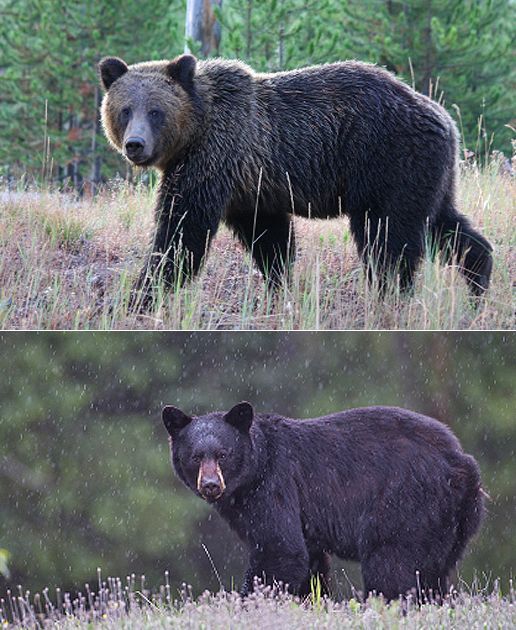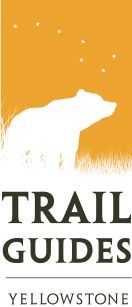Yellowstone Bears
Bears & Bear Safety Tips
Hiking in Bear Country
Bears & Bear Encounters in Yellowstone
This is one of the most important topics regarding backcountry travel in Yellowstone. Educating yourself about bears, their appearance and their behavior is important if you plan on spending time hiking or backpacking in the Yellowstone ecosystem. As of 2022 there are an estimated 965 grizzly bears living in Greater Yellowstone Ecosystem, and while encounters are rare, if you frequent the backcountry you may eventually have an encounter with a bear.
For the most part bears are generally shy and solitary animals except during the mating season, or if the bear is a mother with cubs. If given enough warning bears will usually avoid confrontations with humans. While traveling through the wilderness in Yellowstone it's important to pay attention to your surroundings and make plenty of noise to reduce the chances of a surprise encounter. If you should meet a grizzly bear on the trail DO NOT RUN. This will trigger the bears natural predatory instinct and it could charge or chase you. Bears can sprint at nearly 30 mph so trying to outrun a bear is futile. Stay calm and back away slowly. If you're in a group, stay together so you appear larger to the grizzly. Avoid eye contact and talk softly. Remove your bear spray and assess the situation further. Always take note of the wind direction if you plan on using your bear spray. A strong breeze may carry the pepper spray back in your direction. On windy days it may do YOU more harm than the bear.
If the bear exhibits the following behavior; huffing, growling, jaw popping or swatting at the ground the bear is clearly agitated and may charge. Back away slowly. If a bear does charge try to remain calm and stand your ground. This is often a bluff charge and the bear may abruptly stop and/ or veer away at the last moment. Have your bear spray out and be ready to use it (see our section below on bear spray)! However, if the bear makes contact lie face down and cover your neck with your arms. Always leave your backpack on for additional protection and remain motionless until the bear has moved on.
It is nearly impossible to predict how any bear encounter will unfold. Like people, bears have their own personalities. Some may be naturally aggressive while others are more docile. Every situation is unique and requires sound judgement to prevent possible injury or even death.
Preventing Bear Attacks
- Make noise when hiking. Clap, shout or sing.
- If approached DO NOT RUN - bears may interpret you as prey if you run.
- Never approach a female bear with cubs for any reason.
- Do not hike after dark.
- Watch for signs of animals including tracks and scat.
- Carry bear spray and know how and when to use it.
- Avoid animal carcasses. Bears may be feeding or resting nearby.
Identifying Black Bears & Grizzly Bears in the Wild
Identification is always important when observing bears in the backcountry. Proper recognition will allow you to act appropriately should you come face-to-face with a black bear or grizzly bear. Do not rely solely on color to identify either species of bear. Both animals can share similar color characteristics. Here are a few physical attributes that can help you determine the differences between a black bear and a grizzly bear.

Top Photo
Grizzly Bears (Ursus arctos horribilis)
While grizzly bears can be found anywhere in the park they tend to forage in open meadows, and the larger valleys which occupy a large portion of the park. Grizzly bears require a larger territory, and like most animals in the park they will use the trail systems to move from one location to another as they search for food.
- Grizzly bears tend to be brown, cinnamon or blonde colored.
- Grizzlies have a very pronounced shoulder hump.
- Grizzly bear claws are much longer with less of a curve (2-4" in length).
- Grizzly bears weigh between 200-700 lbs. Males are much larger than females.
- The snout is shorter and the face is round or dish-shaped compared to the black bear.
- Ears are round and smaller than those of a black bear.
Bottom Photo
Black Bears (Ursus americanus)
Black bears tend to utilize the forested areas more than grizzlies and their claws are better suited for climbing trees which helps them escape danger or other predators. Although black bears are generally less aggressive than grizzly bears it is always best to give them just as much space.
- Black bears are black, brown or cinnamon colored (color is not reliable for identification).
- No prominent shoulder hump like the grizzly bear.
- Black bear claws are much shorter with a greater curve or hook (1 1/2" in length).
- Black bears weigh between 150-300 lbs. with males being heavier than females.
- The snout is straighter and more pronounced on a black bear.
- Ears are taller on black bears.
- Rear end is higher than the shoulder.
Emily took this video at the Bunsen Peak Trailhead. Notice how quickly and effortlessly the third grizzly bear moves to catch up to its sibling. Never run from a bear!
Bears & Bear Spray
If you're planning a day hike or backpacking trip to Yellowstone we recommend carrying a can of bear spray (7.9-10.2 oz.). This product can be very effective (if used properly) and it may save your life in the event of a bear attack. If you've never used bear spray it's important to understand how the product works and what to do during a bear encounter. Bear spray should only be used as a last resort!
First, always stay alert and make noise while hiking. Hike in groups of three or more if possible. This will minimize your chances of surprising a bear. Carry the bear spray on your hip belt or chest strap so you can grab the canister as quickly as possible. Do not keep bear spray hidden inside your backpack or out of reach—seconds make all the difference. When in camp or while sleeping keep the canister nearby with the safety clip in place. Most safety caps are designed to glow in the dark so you can quickly locate the canister even in the dark. If you're traveling with a large group of people, each person should carry their own canister of bear spray and each person should understand how to use it. It may be up to you to help another backpacker should a surprise attack occur.
Bear & Bear Spray Safety Tips
- Only use bear spray as a last resort.
- First, DO NOT RUN! A bears natural instincts will interpret you as prey if you run.
- Try to remain calm.
- Hold the can of bear spray firmly and remove the safety clip with your thumb.
- If a bear charges, use the pepper spray at a distance of 30-60 ft.
- Spray toward the bears head and face.
- Be aware of the wind direction before discharging the pepper spray.
- Do not use bear spray on people, clothing or backpacks. It does NOT work like an insect repellant!
We recommend either UDAP or Counter Assault brands (7.9-10.2 oz. canisters). They have a range of up to 30-40 feet and produce a broad, powerful blast of highly concentrated Capsaicin or Oleoresin Capsicums spray. These products are generally oil-based sprays. When discharged they produce a concentrated cloud or fog that remains airborne much longer because of this ingredient. Contact with your skin or eyes makes it difficult to remove and will cause severe discomfort. All clothing, backpacks, etc., contaminated with pepper spray must be washed thoroughly. Read the directions carefully before using this product. Bear spray is extremely potent and it can severely disable you or anyone nearby if discharged improperly.
Important Note: Carrying bear spray does NOT give you a reason to seek out bears or attempt to get closer to other wild animals. Use common sense and enjoy wildlife from a safe distance.
Bear Spray Lifespan
Depending on the brand, bear spray has a shelf life of around 3-4 years. UDAP states their canister will last for 3 years while Counter Assault is about 4 years. If you've exceeded that timeframe you should consider investing in a new can of bear spray. Aerosol cans will lose pressure naturally over time so it's best to check the date on the canister and replace it based on the manufacturers recommendations.
If you plan on purchasing a can for yourself, both the REI store and Sportman's Warehouse in Bozeman sell bear spray. These stores are located on North 19th Street in the shopping plaza south of Home Depot at 2220 Tschache Street. You can also purchase bear spray at gift shops and visitor centers inside the national park. Another option is to rent bear spray through BearAware, using their convenient bear spray rental network located in both Yellowstone, the Grand Tetons and surrounding gateway communities. Click the link below for details regarding their locations and rental costs.
Safety Regulations When Flying
FAA & TSA regulations: "Bear spray is NOT allowed in checked luggage or in carry-on baggage". Before flying visit the Transportation Security Administration (TSA) website for a comprehensive list of items prohibited in carry-on bags or checked luggage.
Trail Guides Yellowstone will provide guests with a canister of bear spray, a bear spray holster and instructions for its use during your guided trip.


